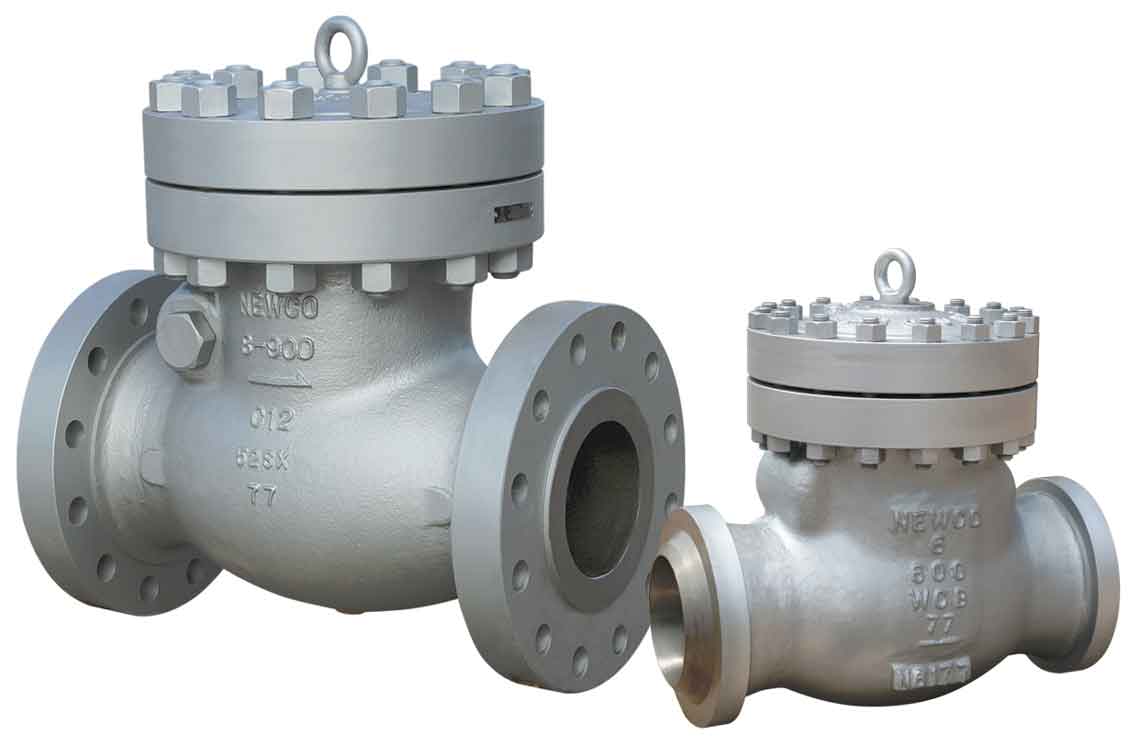Tom Wheatley Piston Check Valve
API Spec 6D–compliant valve, especially effective in scenarios with pressure surges and pulsating flow
Nonslam, reliable operation that stands up to excessive wear.
Published: 01/09/2015

Published: 01/09/2015

Check valves, also known as nonreturn or one-way valves, enable fluid to flow one way in a pipeline. A clapper hangs from a hinge, clapper shaft, or pin mounted to the underside of the bonnet. This design inhibits backflow in a line.
Because of their simple design, check valves generally operate without automation or human interaction and instead rely on the flow velocity of the fluid to open and close. This means they do not have a method of outside operation like a handle or lever. The minimum upstream pressure required to operate the valve is called the cracking pressure, generally between 1 and 5 psi. Check valves are designed specifically with this number in mind.
The degree of opening on a check valve is determined by the flow rate. The higher the flow rate, the more open the valve will be until it reaches its maximum, full-open position. On many check valves, the full open position is approximately 85°.

Swing (tilting-disc) check valves consist of a clapper with a disc that is convex on the upstream inlet side and flat on the downstream outlet side. For API Spec 600 valves, this disc swings on a hinge that is mounted to the bottom of the valve bonnet. For API Spec 6D valves, the typical construction is a cast pocket in the valve body with a drop-in shaft or pin-and-bushing arrangement that the clapper will turn on. This type of construction requires some sort of restraint to keep the clapper in the pocket. The new design features improved modularity and facilitates easier assembly, enabling different configurations to be assembled with a base design.
Nozzle (axial flow) check valves have a spring-loaded disc that translates horizontally. The spring allows for a nonslam design in that the effects of water hammer are eliminated. These are designed to be in the full open position, even at minimum flow rate, to ensure performance. Nozzle check valves can be installed in both buried and above-grade applications and are ideal for gas applications.
Ball check valves include a spherical ball clapper that is sometimes spring loaded to seal at pressures below the cracking pressure. Because of the spherical design, these valves can easily wear from prolonged use and require frequent maintenance; therefore, they should be installed in places that are easy for repair teams to access.
Diaphragm check valves consist of a rubber diaphragm clapper that flexes open when the pressure on the upstream side is greater than the pressure on the downstream side and closes when this pressure is equalized or lowered below a set pressure differential.
Stop check valves are usually constructed similar to a swing check valve but have an additional external control mechanism—such as an actuator, lever, or handwheel—that enables the valve to be deliberately closed regardless of flow pressure.
Duckbill valves enable flow to proceed through a soft tube that feeds into the downstream side of the valve wherein backpressure collapses the tube and cuts off the flow.
The main advantage of a check valve is its simple design. Generally, check valves also are smaller and easier to install compared with other valve types, making maintenance easier and more efficient. Check valves can be designed with specific nonslam features to reduce noise and seal wear. ENTECH nozzle check valves are commonly selected for this feature in LNG pump stations and gas compressor stations. Additionally, because of their simple, streamlined design, TOM WHEATLEY check valves and ENTECH check valves have lower pressure drops (less than 1 psi) than comparable piston check valves.
Because of their simple design and versatile material options, check valves are used in a variety of markets and applications. Check valves can be designed to API Specs 600 or 6D standards. Typically, check valves designed to API Spec 600 specifications are used in the industrial market. Usually designed with reduced port sizes, these valves have special bolting and cover sealing, angle seating, a two-piece clapper and arm unit, and hard chrome trims. Check valves can be designed to various wall thickness requirements and feature pressure and temperature ratings per ASME B16.34. API Spec 600 and 6D check valves, which are designed for use in the oil and gas industry, have removable seats as well as bonnet-to-body joint connections for seals, bonnet gaskets, and cover bolting.
Specialty valves for subsea operation at extremely high pressures and low temperatures can be designed into a system. The TOM WHEATLEY valve features a unique, free-swinging clapper. If reverse flow or a critical pigging operation is required, the clapper can be actuated manually, hydraulically, or via ROV and held in the full-open position. This feature is also available in nonsubsea applications as well.
![NEWCO valves are available in sizes from 1/4 to 24 in [5 to 600 mm], ASME Classes 150 to 1500, and in various grades of stainless steel.](/-/media/images/vl/valve-academy/article/how-it-works-check-valves-b.jpg?la=en&h=799&w=1140&hash=F0DC400DEC9B2250B285A4B82C40259D)
NEWCO gate, globe, and check valves are ideal for standard and critical power industry applications. The pressure-seal bonnet joint eliminates the body and bonnet flanges, reducing weight and simplifying the application of exterior insulation. Contrary to bolted bonnet valves, internal pressure applied to a pressure seal valve forces the sealing elements into tighter contact—the higher the internal pressure, the tighter the seal. The tilt-disc check valve design yields minimal restriction in low-velocity environments and is ideal for preventing backflow in unidirectional flow applications in horizontal flow. Additionally, the tilting-disc design offers closing that reduces slamming.